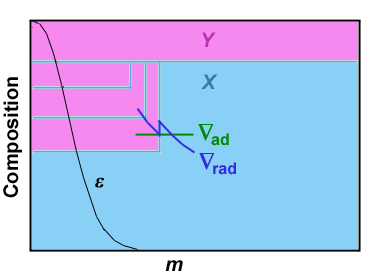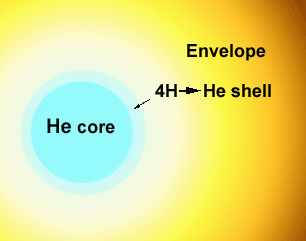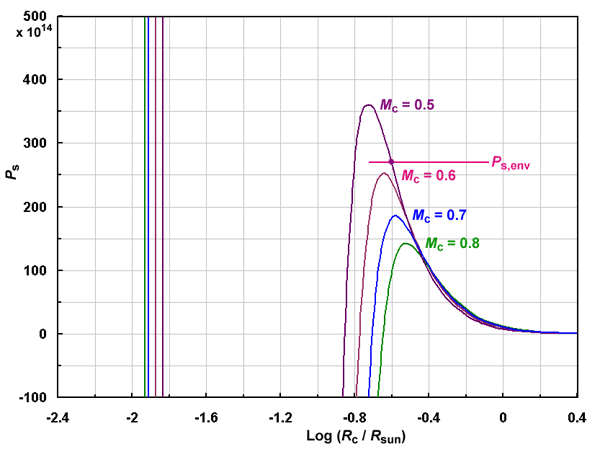Outline
10. Star aging
1. Main sequence
The "four" equations for stellar structure assuming quiescent aging again:
4πr 2ρdr = dm
dl = ε dm
Gravitational and Nuclear energy generation:
ε = εo
(ρ /ρo) λ
(T /To) ν
4πr 4dP = −Gm dm
Equation of State:
P = Po
(ρ /ρo) β
(T /To) α
Radiative layers
64π 2r 4ac T 3dT =
− 3κ l dm
Mean opacity: κ = κo
(ρ /ρo) n
(T /To) −s
Convective layers
P dT = T(1−1/γ) dP
Consider two stars on the zero-age main sequence with slightly different
masses M = Mo + δM, and write the variables as:
y(m/M) = yo(m/Mo) +
(∂y/∂M) δM =
yo(m/Mo)
[1 + (∂ln y /∂M) δM].
Substitute into the equations (illustrating only the radiative set):
4πro 3
[1 + 3 (∂ln r /∂M) δM]
ρo
[1 + (∂ln ρ /∂M) δM]
d ln r = mo
[1 + (∂ln m /∂M) δM]
d ln m
lo
[1 + (∂ln l /∂M) δM]
d ln l =
εo
[1 + (λ ∂ln ρ /∂M
+ ν ∂ln T /∂M) δM]
mo
[1 + (∂ln m /∂M) δM]
d ln m
4πro 4
[1 + 4 (∂ln r /∂M) δM]
Po
[1 + (β ∂ln ρ /∂M
+ α ∂ln T /∂M) δM]
d ln P = Gmo2
[1 + 2 (∂ln m /∂M) δM]
d ln m
64π 2ro 4
[1 + 4 (∂ln r /∂M) δM]
ac To4
[1 + 4 (∂ln T /∂M) δM]
d ln T =
xxxx − 3κo
[1 + (n ∂ln ρ /∂M
− s ∂ln T /∂M) δM]
lo
[1 + (∂ln l /∂M) δM]
mo
[1 + (∂ln m /∂M) δM]
d ln m .
Now assume homologous behavior; i.e. the partials
∂ln y /∂M are independent of m.
Then the logarithmic derivatives d ln y /d ln m
are independent of M and all factors containing constants
(and yo's) cancel because we know that the
yo's satisfy the equations.
If we keep only terms linear in δM, δM also
drops out.
We are left with four equations in the four unknowns ∂ln y /∂M,
which we can express as the vector equation
| x3x |
0 |
1 |
0 | |
∂ ln r | |
1 |
|
| 0 |
x1x |
− λ |
− ν | |
∂ ln l | |
1 |
|
| 4 |
0 |
xβx |
xαx |
x•x |
∂ ln ρ |
x=x |
2 |
∂ lnM |
| 4 |
− 1 |
− n |
4 + s |
|
∂ ln T |
|
x1x | |
The solution is:
∂ ln r /∂ lnM = (1 − x/D) /3
∂ ln l /∂ lnM = 1 + (λ x − ν z) /D
∂ ln ρ /∂ lnM = x /D
∂ ln T /∂ lnM = − z /D,
where
x = 2 (α + ν − s − 4)
z = 2 (β + λ + n)
D = (3β − 4) (ν − s − 4) −
α (3λ + 3n +4).
[Assuming re-ordered equations, multiplying one by −1, and that
H&K have done their algebra right on p. 25.]
Since these derivatives are assumed independent of m, we may assume
that they represent values of
∂ ln R /∂ lnM
∂ ln L /∂ lnM
∂ ln ρc /∂ lnM
∂ ln Tc /∂ lnM,
the unknown boundary values.
Assume
λ = 1, ν = 18; (CNO burning)
β = 1, α = 1.2; (perfect gas law + some radiation)
s = 1.5, n = 0.3; (electron scattering + some ionization).
Then
| ∂ ln R /∂ lnM | = |
0.75 | 0.7 |
| ∂ ln L /∂ lnM | = |
3.52 | 3.5 |
| ∂ ln ρc /∂ lnM | = |
−1.25 | −1.3 |
| ∂ ln Tc /∂ lnM | = |
0.21 | 0.2 |
The bold numbers describe the 'real' upper main sequence, so the estimation is not far off.
Of course, the power exponents were adjusted to make the match; however, the values
are reasonable. A little experimentation will show that the derivatives are quite
sensitive to the values of the exponents, particularly β, α,
and n.
2. Semi-convection
For stars more massive than 10Msun, the core convection grows
in m as hydrogen is depleted, producing a discontinuity in X.

The adiabatic gradient is virtually continuous across the discontinuity.
The radiative gradient ∇rad =
(3 κ P l ) /(16πacG m T 4) decreases
outward mostly proportional to 1/m (l is already ≈ L), and
full convection stops when it drops below ∇ad.
Both P and T are continuous across the discontinuity.
However, κ ≈ 0.2 (1 + X ) becomes discontinuous due
to the discontinuous electron-to-baryon ratio.
Therefore ∇rad is higher in the unprocessed envelope.
Convection will procede until ∇rad is reduced to ∇ad by
mixing in some helium and smoothing out the discontinuity.
Nuclear evolution chews into the bottom edge, maintaining the smoothing
convection in a marginal state called semi-convection.
Semi-convection is very difficult to treat.
The amount of hydrogen it feeds into the core significantly affects the total fuel
available on the main sequence.
3. Post main sequence
Why does a star move in one direction (generally L increases
slowly by a factor of 2 to 3, and Te decreases by
about 25%) on the main sequence, and then suddenly expand with
decreasing surface temperature at some point?
What triggers the rapid transition?
Why doesn't the star stay near the main sequence as it consumes hydrogen
in a shell around a helium core?

The virial theorem and homology argue for a maximum He core mass of about
0.08M above which stable nuclear aging is no longer possible.
Assume an isothermal core at a temperature maintained by the hydrogen
burning shell right above it.
As long as the system is stable, the nuclear reactions will provide an
effective thermostat.
The virial theorem for a core with outside pressure is
2K + Ω = 3PsV,
where Ps is the core surface pressure and V is the
volume.
Substitute
2K = 3 (McNAv /μc )
kTc
Ω = − (3/5) GMc2/Rc
V = 4πRc3/3
and solve for Ps
Ps =
(3/4π) (McNAv /μc )
kTc
Rc−3 −
(3/20π) GMc2 Rc−4
In the event that the core becomes (non-relativistically) degenerate,
we may add a term
Pe = 1.004×1013
(4π μe /3)−5/3
Mc5/3
Rc−5.
in solar units:
Ps =
11.6×1014μc−1
T7 Mc Rc−3 −
5.38×1014
Mc2 Rc−4 [ +
5.60×1012
Mc5/3
Rc−5]Rc<0.03.
The following figure shows the form of Ps as a function of
Rc for various Mc at the typical values
T7 = 2.2 and μc = 4/3.

Now consider the envelope.
If we assume that the core is relatively small,
we may estimate interior conditions from the polytropic relations:
4π(n + 1) θ′ξ12
Ps =
GM 2/R 4
(n + 1) (−ξθ′ )ξ1
Tc =
(Gμenv/NAk) M /R .
Assuming n = 3 ('Eddington standard model') and solar units,
Ps =
1.24×1017 M 2/R 4
Tc =
1.96×107 μenv
M /R .
Substuting from the second relation into the first gives:
Ps =
8.42×1015 μenv−4
T74 M −2.
Assuming T7 = 2.2, μenv = 0.62,
and M = 7, Ps = 272×1014.
This value is marked on the figure with a horizontal line, since it is 'independent'
of core values.
Then, aging on the main sequence continues as long as the core mass Mc
remains small enough that the peak from the virial theorem configuration remains
higher than the envelope pressure.
The surface pressure solution is at the crossing of the two curves, marked with a dot.
As the core grows, the virial peak drops.
At a critical mass, the envelope heating can no longer sustain the internal pressure of
the core, and the core then begins to collapse on a Kelvin-Helmholtz timescale
to either degeneracy or the ignition of the 3-α process, which ever comes
first.
We can find that critical mass by evaluating the derivative of the virial formula
with respect to Rc, setting it to zero to find Rmax,
substituting this value into the virial formula to find Pmax,
and then setting that equal to Ps, env.
dPs/dRc =
− 34.8×1014μc−1
T7 Mc Rc−4 +
21.5×1014
Mc2 Rc−5
= 0.
so
Rmax = 0.618 Mc μc
T7−1, and
Pmax =
12.3×1014μc−4
T74 Mc−2.
Setting Pmax = Ps, env and solving for Mc
gives
Mc =
0.38 (μenv /μc)2 M.
A more accurate solution with realistic stellar modeling leads to
Mc =
0.37 (μenv /μc)2 M,
called the Schönberg-Chandrasekhar limit.
[Note: such close agreement is fortuitous and results from including the (3/5) coefficient in
Ω. The results are very sensitive to the relative strengths of the virial terms.]
Filling in the stated values for the molecular weights gives
Mc =
0.080 M.


